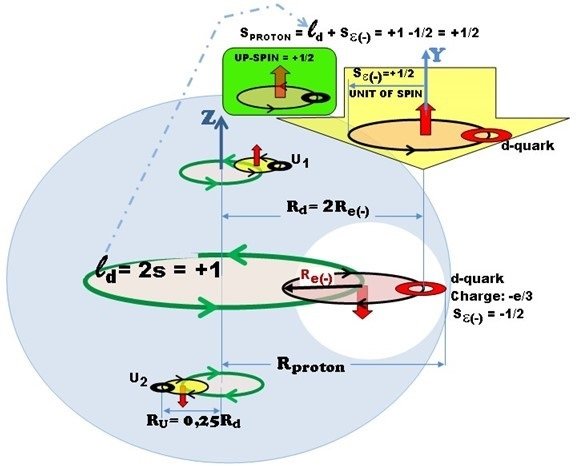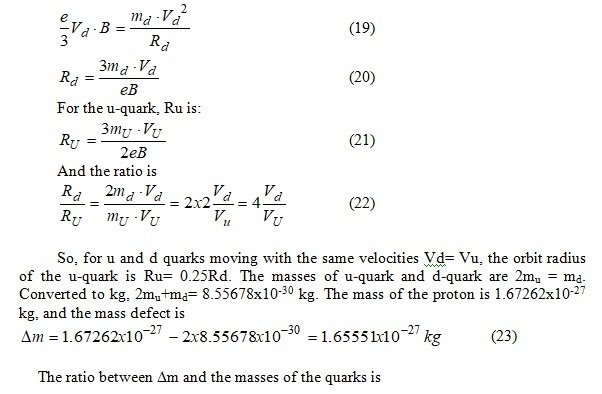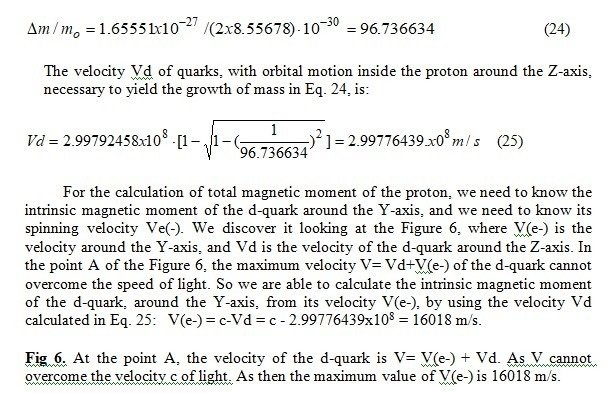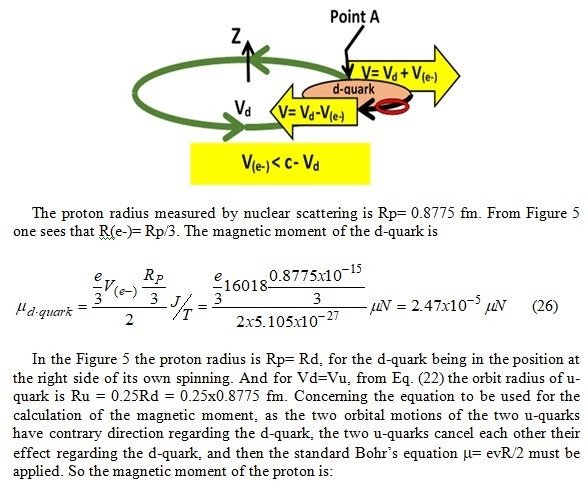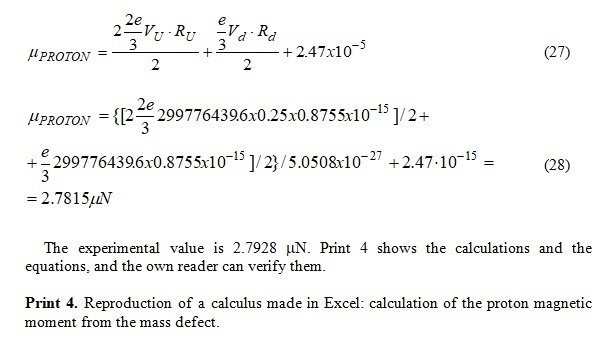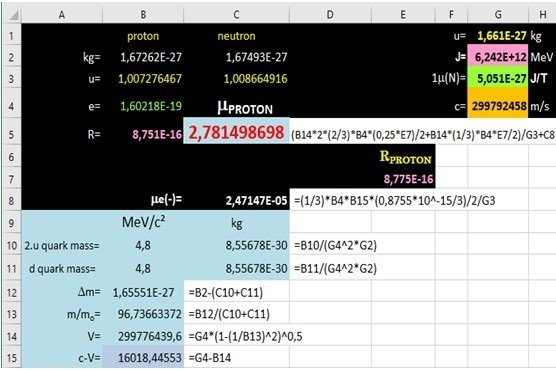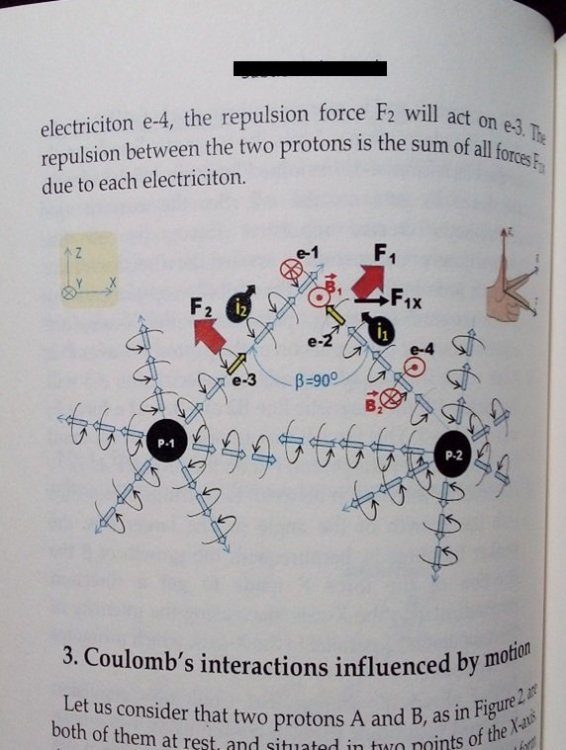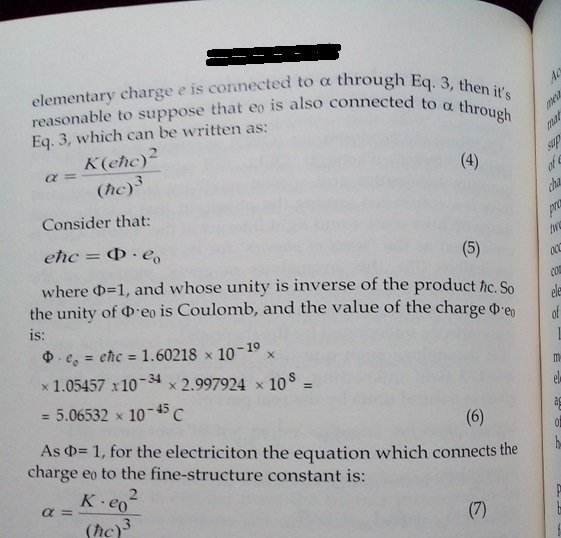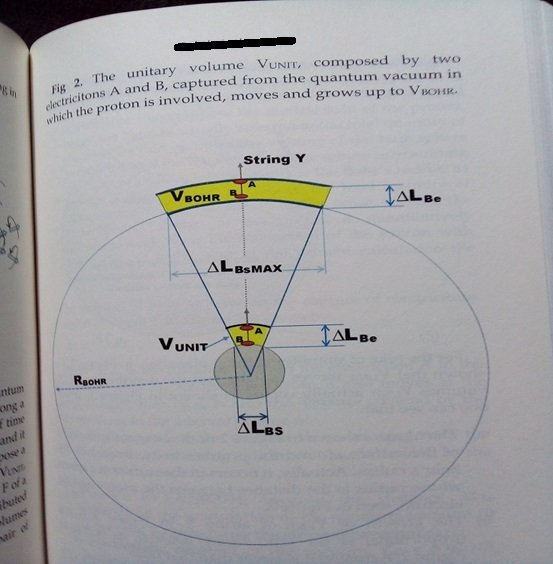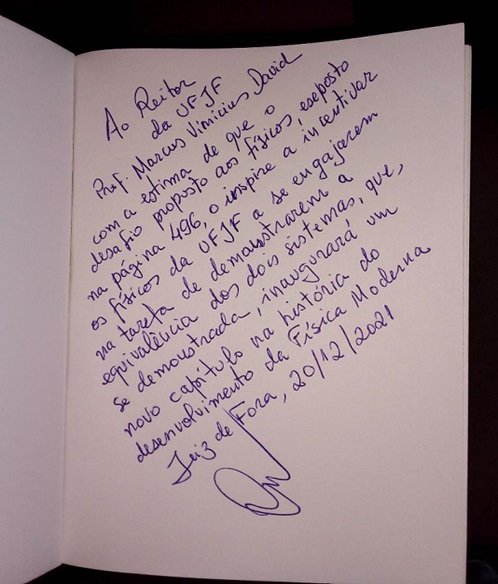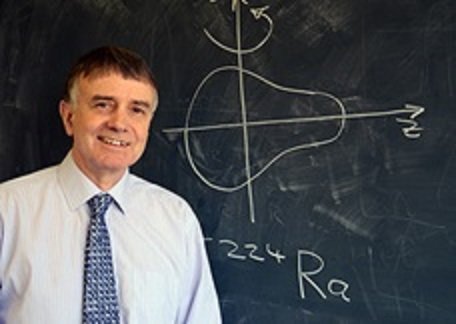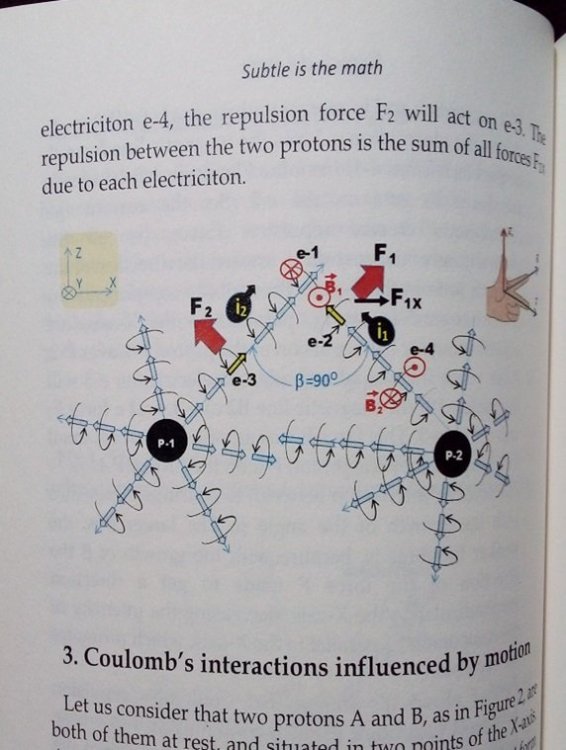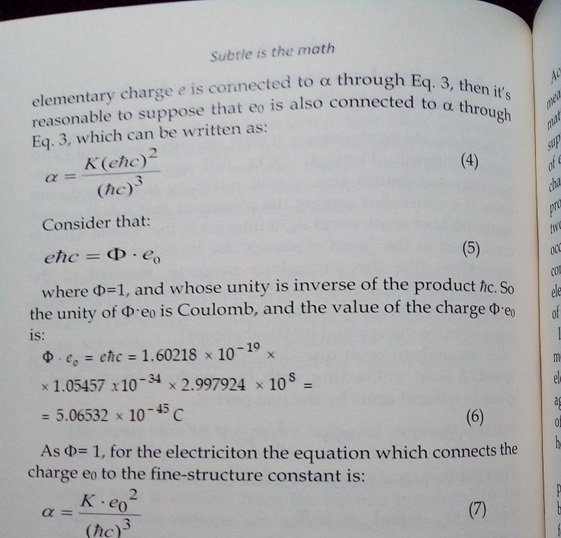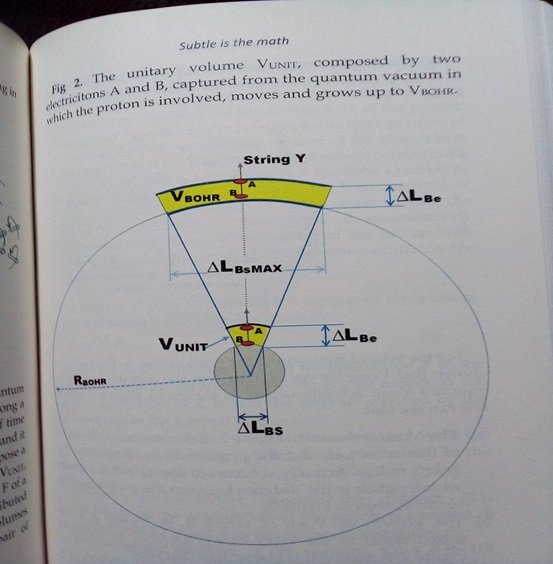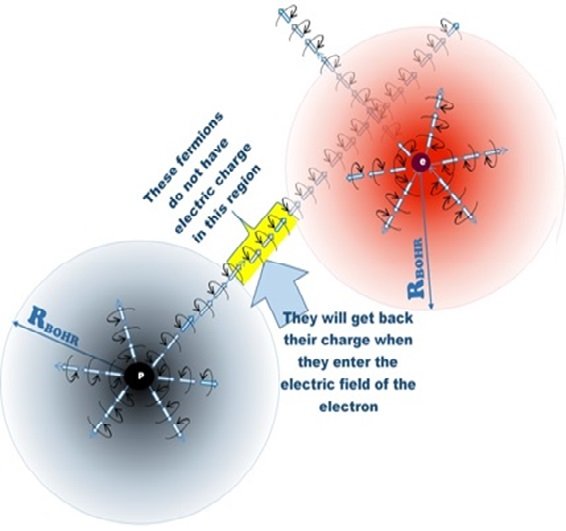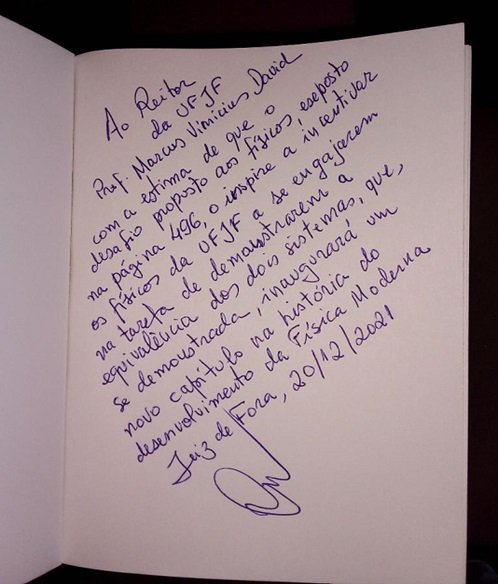

vova
Members-
Posts
5 -
Joined
-
Last visited
Content Type
Profiles
Forums
Events
Everything posted by vova
-
The proton model according to particle physics is seriously threatened by properties of the proton detected by experiments in the last two decades. The drama of the current proton model is that it was developed from the principle of symmetry, and therefore it is impossible to explain a recently discovered property of the proton, which requires the proton to have an asymmetric structure. We will talk about this enigma, which invalidates the current proton model, at the end of this topic, after showing the calculation of the proton's magnetic moment, through a new model, which, in addition to being asymmetric, has another property that does not exist in the current model of proton: in this new model, the quarks have an angular momentum, which does not exist in the current model, because in this new model of proton, the quarks rotate at a speed close to that of light around the Z-axis that passes through the center of the proton. This lack of angular momentum in the current proton model has also introduced other puzzles that challenge the model, including one stemming from a 1987 experiment that detected that quarks can contribute only 25% of the proton's spin. In 2014 Nuclear Physics B published an article [Nocera E.R., Ball R.D., Forte S., Ridolfi G., Rojo J. (2014). nucl. Phys. B], where the authors show that, from a structure of protons with quarks interacting via Yukawa interaction, there is no way to find an asymmetry capable of supplying the differences detected in the experiments. That's why theorists nowadays try to solve this puzzle by assuming that the gluons are responsible for the asymmetry in the proton's structure. New structure of the proton Proton structure is at Figure 5. Gluons are not shown, because there is no need to consider them as contributors for the proton asymmetric structure (indispensable for the explanation of production of W boson in polarized beam of protons in scattering experiments) as will be shown. The down quark crosses orthogonally the magnetic lines of the magnetic field induced by the rotation of the two up quarks. As is known, when an electric charge is moving rectilinearly, but suddenly it enters in a magnetic field, in a way that it crosses orthogonally the lines of the field, the charge starts to move with circular motion. That’s why the down quark gets its orbital angular momentum inside the structure of the quark, L= m.v.R. The same happens with the up quarks, since they cross orthogonally the magnetic lines of the magnetic field induced by the down quark. Fig 5. Structure of the proton, with the three quarks moving in circular trajectory around the Z-axis. Each u-quark is formed by one fermion of the quantum vacuum with charge +2e/3, and the d-quark is formed by one fermion with charge –e/3. Analyzing the proton structure in the Figure 5, we note that: a) At the top (inside the green rectangle) is shown that positive spin s=+½ of quarks has counter-clockwise rotation b) Inside the big yellow down arrow, the spin of d-quark is due to its rotation around the Y-axis. The unity of positive spin s= +½ is due to the d-quark moving with counter-clockwise rotation (if d-quark would have clockwise rotation, its spin would be negative, s= -½). c) Inside the structure of proton (blue sphere), d-quark has counter-clockwise orbital motion around the X-axis, and negative spin s= -½ around Y-axis. If it had positive spin s= +½, its contribution for the proton magnetic moment would be negative. But because it has s= -½, its contribution is positive. d) Regarding up quark U1 and d-quark: · Both them have orbital motion around the Z-axis in counter-clockwise direction. · They have contrary spins · So, if they had the same sign of charge, they would have tendency to cancel each other their magnetic moments. · But as U1 has positive charge, and d-quark negative, both them contribute for a positive magnetic moment. e) Up quarks U1 and U2 have contrary spins. Then: · If they were moving in the same direction around the Z-axis, they would cancel each other their magnetic moments. · But as they move in contrary direction, they add their contribution for a positive magnetic moment. f) Therefore, all the three quarks contribute for a positive magnetic moment. g) The two u-quarks have contrary spins, and contrary orbital angular momentum, and therefore they do not contribute for the total spin of the proton. h) The d-quark has rotation with radius Re(-) around its own spinning center (Y-axis), and it with radius Rd= 2Re(-) around the Z-axis of the proton. Calculation of the proton magnetic moment from the mass defect The masses of the u and d quarks, measured by experiments, are respectively 2,3+0,7;-0,5 and 4,8+-,5;-0,3 MeV/c². Will be used 2.45 and 5.35 MeV/c². As the two u-quarks cancel each other their contribution for the spin of the proton, there is no need to know what are the values of their orbital angular momentum. However, their orbital motions contribute for the magnetic moment, and so there is need to know what is the value of their orbital radius Ru. This is calculated ahead. The equilibrium between the magnetic and centrifugal forces on the d-quark is given by: Proton spin puzzle solved Relativistic Heavy Ion Collider (RHIC) is the only facility in the world capable of colliding spin-polarized protons. The experiments showed that, if some results are obtained from the collision of beams of protons with their spins aligned in a particular direction, the ability to flip the polarization supply different results, as for instance different rate of W bosons production. A 1987 experiment showed that quarks can account for only a small portion of a proton’s spin. The first measurement showed it was 0 percent, but later measurements suggested that quarks can contribute up to 25 percent of the proton’s total spin. Those different results imply that there is need to have an asymmetry in the proton’s structure. In 2014 Nuclear Physics B published a paper [14], where the authors show that, from a structure of proton with the quarks interacting via the Yukawa’s interaction, there is no way to find an asymmetry capable to supply the differences detected in the experiments. That’s why nowadays the theorists are trying to solve such puzzle by supposing that gluons are responsible for the asymmetry in the structure of the proton. From the asymmetric proton’s structure seen in the Figure 5, one realizes the puzzle can be explained, because: 1- The up quark U-1 and the down quark have their translation movements in the same direction. 2- The mass of up quark is half of that of the down quark 3- The orbit radius of the up quark around the center of the proton is 2.5 times shorter than that of the down quark, and as they move with the same velocity, then the up quark performs a complete revolution in a time 2.5 times shorter than that spent by the down quark 4- The distribution of charges in rotation is asymmetric, because there are two charges (+2/3 and -1/3) moving in counter-clockwise direction, and one charge +2/3 moving in clockwise direction. Attempting to explain experiments that require an asymmetric structure of the proton, such as this: Theorists nowadays try to solve this puzzle by assuming that the gluons are responsible for the asymmetry in the proton's structure seems to make no sense, because: 1- all physics, as well as nuclear physics, was developed from the principle of symmetry 2- so why wouldn't gluons obey the principle of symmetry? .
- 1 reply
-
-2
-
There is not in current theoretical physics an atomistic structure of the electric field, despite more than 70 years ago Wolfgang Pauli said in his Nobel Lecture: "From the point of view of logic, my report on ‘Exclusion principle and quantum mechanics’ has no conclusion. I believe that it will only be possible to write the conclusion if a theory is established which will determine the value of the fine-structure constant and will thus explain the atomistic structure of electricity, which is such an essential quality of all atomic sources of electric fields actually occurring in Nature." The book *************** was published in 2021, by ***********. In the first article of the book, entitled "Relation between QED, Coulomb's Law and fine-structure constant", the theory of the structure of the electric field was proposed, composed of fermions of the quantum vacuum, which move with the speed of light. In the figure 1 below you can see the atomistic structure of two protons, P-1 and P-2, repelling each other. The electriciton e-1 of proton P-1 is interacting with the electriciton e-2 of the proton P-2, being F1 the repulse force between e-1 and e-2. And the electricitions e-3 an e-4 will interact with a force F2 when they arrive to the point where the electrictions e-1 and e-2 are interacting just at the present instant. Figure 1 On page 92 of the book is shown the calculation of the value of the electric charge of the fermions that make up the electric field. The calculation is very simple, performed between equations 4 and 6, seen in the figure 2. The value obtained is 5.06532x10-45 C, in the Eq. 6. Figure 2 Before be published in the book ******************, the article was rejected by several journals, such as the European Physical Journal C, International Journal of Modern Physics, Foundations of Physics, and many others. One of the Editor-in-Chief of the European Physical Journal Plus rejected the article with this Report: =========================================================== Ref.: Ms. At the. EPJP-D-20-00700R1 Relationship between QED, Coulomb's Law, and fine-structure constant The European Physical Journal Plus Dear Dr Guglinski, The main idea of the article is based on classical notions such as particle motion and electric current and magnetic field seem to have received fundamental roles. This is evident from the numbers presented in the newspaper. These notions are untenable in the microscopic world where the wave-particle duality is essential even if the author feels "outsider" and the gauge field plays an essential role. They have been supported by experiments for many years. The paper will not be understood and will never be accepted by any other physicists unless the author provides, not subjective evidence (such as that which the author considers "strange"), but objective evidence of defect in the standard interpretation, which is lacking at present. paper. I think the article does not meet the scientific standards required by EPJ Plus and therefore I reject it. yours sincerely Hiromichi Nakazato =========================================================== But I knew that that simple calculation of the electric charge of the fermions, whose value obtained was 5.06532x10-45 C, was very simple and not enough to convince the physicists. And so, while Dr. Nakazato was analyzing my article, I dedicated myself to the task of proving that, starting from that value of the charge of the quantum vacuum fermions, it was possible to calculate the value of the electric charge of the proton, if its electric field is really constituted by those fermions, moving with the speed of light. This calculation was successfully performed in the article "Calculation of proton charges from the electric charges of fermions of the quantum vacuum", and the calculation procedure is quite simple, as explained ahead. ========Calculation procedure======== Considering that the electric field of the proton is composed of electricitons with charge 5.06532.10-45 C, as calculated in Relationship between QED, Coulomb's Law, and fine-structure constant, then if we calculate the amount X of electricitons that make up its electric field, the charge of the proton in Coulomb is: e= X.e0 e= X· 5.06532.10-45. The task at hand is to calculate X. However, of course, it's not that easy. It is necessary to consider the quantization of energy. =========================================================== But although the calculation procedure is quite simple, the calculation itself is sophisticated, because it involves several constants of physics, such as Planck's constant, the fine structure constant 1/137, the speed of light, the electrostatic constant of vacuum , and the Bohr radius. The figure 3 below shows where the calculation starts from. There you can see two fermions, A and B, moving in the proton's electric field. They leave the proton's body, where they were captured from the quantum vacuum around the proton's body, and travel with the speed of light for a distance equal to the Bohr radius. Figure 3 The result of the calculation is fantastic. The experimentally measured value of the proton's charge is 1.6026x10-19 C, and the value obtained by calculation is 1.60218x10-19 C. The article was submitted to the European Physical Journal Plus, under the care of Editor-in-Chief Hiromichi Nakazato. But two days after the article was submitted, it was rejected by Editor-in-Chief Kumar Gupta. That is, he did not want the article to be evaluated by Nakazato. And obviously Kumar Gupta didn't even read the article, because in two days he couldn't reliably assess the merits of the calculation exposed in the article. For serious physicists (who are not traitorous pickaxes of the scientific method and who do not spit on Mathematics, like Dr. Gupta) the calculation of the electric charge of the proton, exposed in this article, is one of the most impressive calculations in physics. Any serious physicist, who respects Mathematics, is amazed. This impressive and successful calculation also justifies what is explained, in the end of the paper, on the properties that fermions start to possess when they are captured by the proton and start to compose its electric field: =========================================================== 1- A fermion e-1 from the electric field of a proton A only interacts with a fermion e-2, from the electric field of a proton B, where the density of the quantum vacuum around each of the protons is sufficient to give to the fermions e-1 and e-2 the property of having interaction. 2- And this quantum vacuum density, sufficient to provide the interaction of the two fermions e-1 and e-2, only occurs within the space limited by the Bohr radius. 3- Figure 4 illustrates these properties, for the attraction proton-electron. =========================================================== Figure 4 And what is the consequence of this fantastic result obtained with the calculation of the electric charge of the proton, from the electric charge of the fermions of the quantum vacuum? The consequence is that the successful calculation demonstrates that the coupling mechanism of electric fields, according to Quantum Electrodynamics, does not correspond to the existing interaction mechanism in Nature. According to Quantum Electrodynamics, a proton and an electron attract each other through the emission of photons. In calculus, an abstract mathematical concept is adopted, called bispinor. But what happens in Nature is that the proton-electron attraction is produced by the interaction force of fermions from the proton field with fermions from the electron field. Each fermion has a spin. And since there are two interacting fermions, there is interaction between two spins. That is why in Quantum Electrodynamics it was necessary to adopt the concept of bispinor, because it was through this concept that it was possible to obtain the mathematical equivalence between what is calculated in Quantum Electrodynamics and what realy occurs in Nature. At the end of the book ****************, a challenge is proposed to physicists: to demonstrate that the mechanism of photon exchange, between a proton and an electron, adopted in Quantum Electrodynamics, is mathematically equivalent to the mechanism of interaction between fermions of the electric fields of the proton and of the electron, existing in Nature. This mathematical demonstration, of the equivalence of the two systems, would be the definitive proof that the photon exchange mechanism, of Quantum Electrodynamics, does not correspond to the existing mechanism in Nature, which occurs through the interaction between fermions of the atomistic structure of electric fields. Invitation to the Rector of the Federal University of Juiz de Fora- UFJF A copy of the book **************** was presented to the Rector of the Federal University of Juiz de Fora- UFJF, at the end of 2021, inviting him to encourage UFJF physicists to look into this mathematical demonstration of the equivalence of the two systems. This demonstration would prove that Quantum Electrodynamics is developed through a mathematical procedure that gives good results, but the physical mechanism adopted in the theory is different from that existing in Nature. Figure 5 - Photo of the page with the dedication to the Rector of UFJF But it is unlikely that the UFJF physicists have accepted the challenge. They are all terrified of reaching the conclusion that the laws of physics, of current Theoretical Physics, do not correspond to the true laws of Nature. Note: the paper Calculation of proton charges from the electric charges of fermions of the quantum vacuum was published also in the peer-review journal Physics Essays, in 2021 Anyone who wants to check the calculations, feel free. Certainly several universities around the world have publications of the journal Physics Essays. Then it will be easy for any university professor, or any student, to check the calculations.
- 1 reply
-
-3
-
NOTE: The book Quantum Ring Theory was published in 2006 by the Bauu Institute Press. The Editor Peter Jones died more than ten years ago, and a second edition was never published, and will never be published. Thus, new books can no longer be purchased, and currently there are only old first edition books, which belong to collectors. In 2018 I submitted to the nuclear physics journal European Physical Journal A the article Proposal of an experiment able to eliminate the controversy: are right or wrong the foundations of the Standard Nuclear Theory? The reason for submitting my article was because, according to the new nuclear model (proposed in my book Quantum Ring Theory) some nuclei with even numbers of protons and neutrons, such as 12Mg24, have zero magnetic moment when excited, although this was impossible, according to current nuclear physics. And since the magnetic moment of many of them (when excited) are absent from the nuclear tables, this absence strengthened my suspicion. Editor-in-Chief Maria Borge rejected the article with the following report. ==================== REPORT ================== European Physical Journal A - Decision on Manuscript ID EPJA-104798 19-Oct-2018 Dear Professor Guglinski: Thank you for submitting your article mentioned above to EPJ A “Hadrons and Nuclei”. The content of the article is not correct. Attempts to generalize the lack of magnetic moment data to the 2+ states of conjugated nuclei to invalidate the theory. Some of the cases you mentioned have been measured and there is good agreement with the shell model calculations. I recommend that you read, for example, PRL114 (2015)062501 and even NJ Stone's old compilation Atomic Data and Nuclear Data Table 90 (2005) 75 where some magnetic moments for 2+ states are already given. Therefore, I cannot accept your contribution for publication in EPJ A. Sincerely yours Professor Maria Borge Editor in Chief European Physical Journal A ================= END OF REPORT ============= In the 2015 paper published in Physical Review Letters, cited by Maria Borge, the authors calculated the magnetic moment of excited 12Mg24. But reading the article I discovered that there was an error in the procedure used in the calculation. And so I wrote a second paper, entitled Mandatory Check for Misunderstanding on Measurements for Magnetic Moments of Excited Even-even Atomic Nuclei, and submitted it to the EPJA. The calculation error in the PRL article is easy to understand, as seen below. 1- The authors used a nuclear table from 2001 to calculate the magnetic moment of 12Mg24 excited with spin 2. In 2001 nuclear physicists were convinced that nuclei with even numbers of protons and neutrons have a spherical shape. 2- But in 2012 the journal Nature published the article How atomic nuclei cluster, reporting experiments that detected that nuclei with even numbers of protons and neutrons have an ellipsoidal shape. 3- Therefore, after 2012 the 2001 table could no longer be applied to nuclei with even numbers of protons and neutrons. The calculation published in 2015 of the magnetic moment of excited 12Mg24 was invalidated, as was the conclusion that excited 12Mg24 had a non-zero magnetic moment. The question was open, and an investigation was imperative. If it were confirmed that excited 12Mg24 has zero magnetic moment, this would invalidate the current nuclear theory. Although Maria Borge has rejected my paper Mandatory check for Misunderstandings on Measurements for Magnetic Moments of Excited Even-even Atomic Nuclei, she must have been extremely surprised to read it, as she came across an event that, in her opinion, could never happen in the history of nuclear physics. But even though this event was impossible to happen, it was happening, and it was amazing. This astonishment of Maria Borge, in seeing that the impossible was happening, is fully justified, for the following reasons: 1- For more than 80 years nuclear physicists have been convinced, without any possibility of supposing they were wrong, that nuclei with even numbers of protons and neutrons are spherical. The main reason they were so sure to firmly believe that such nuclei must be spherical was due to the fact that nuclear physics was developed from the fundamental principle of symmetry, in consequence of which such nuclei must be spherical. 2- If an author proposed a new nuclear model, according to which nuclei with even numbers of protons and neutrons are ellipsoidal, this author could not be taken seriously, because according to current nuclear physics such nuclei can only be spherical, as required by the principle of symmetry. Either this author had terrible knowledge of nuclear physics, or he was simply crazy to propose something that all nuclear physicists knew was impossible. The paper Mandatory Check for Misunderstandings on Measurements for Magnetic Moments of Excited Even-even Atomic Nuclei described the impressive narrative of the impossible event. Here is the impressive narrative exposed in the article, which surprised Maria Borge: ============================================= Narrative in the paper Mandatory Check for Misunderstandings on Measurements for Magnetic Moments of Excited Even-even Atomic Nuclei ============================================== So, let us analyze the method used by Raman at al. in [2], face to historical facts occurred after its publication in 2001. We begin with the description ahead, which is an excerpt of the page 58 of the paper [4], where are related some historical facts. The excerpt begins with a description on some differences between the current nuclear models, and the new nuclear hexagonal floors model, proposed by the author. According to the Standard Nuclear Physics, the even-even nuclei with Z=N cannot have ellipsoidal shape, and therefore my nuclear model with hexagonal floors could not be considered seriously by nuclear theorists, because they knew not only that the principles of the SNP requires a spherical shape for those nuclei, but also because they knew those nuclei have null electric quadrupole moment, and therefore it was mandatory they have spherical shape. Besides, as in that new nuclear model there is a central 2He4, and the nucleons are captured by a string formed by a flux of gravitons (instead of be bound by strong nuclear force, as considered in all current nuclear models), the nuclear theorists had more strong reasons why do not consider seriously a “strange” model formed by hexagonal floors. Obviously the author was aware that a paper, proposing the exotic new nuclear model, would never be accepted for publication in any reputable peer journal of physics. That’s why in 2004 he has decided to meet his several papers in a book form, and to look for a publisher. In the end of 2005 an editor has accepted to publish it, and the book was published in August 2006, with the title Quantum Ring Theory, QRT (see “Ref. E-1” in the end of this excerpt). Spherical distribution of charges has null electric quadrupole moment, Q=0, while ellipsoidal distribution elongated toward Z-axis has Q>0, and elongated toward XY plane has Q<0. As experiments already had detected that even-even nuclei with Z=N have Q=0, then obviously the author had to justify how, in spite of they have ellipsoidal shape, however they have Q=0. The argument, which justifies why they have Q=0, is proposed in the page 137 of the book QRT. Another prediction was regarding the distribution of the nucleons, because, as they occupy places in the corners of hexagonal floors distributed about the Z-axis, then in the Hexagonal Floors Model there is a preferential direction of distribution. In the page 133 is written: “The distribution about the z-axis is a nuclear property up to now unknown in Nuclear Physics.” And obviously such prediction, of the existence of a preferential direction for the distribution of the nucleons, along the Z-axis, was other strong reason for rejection of the new nuclear model, because, according the foundations of the Standard Nuclear Physics, a preferential direction of distribution of nucleons is impossible. In 2012 the journal Nature published a paper demolishing a dogma of current nuclear physics, considered untouchable along 80 years, reporting experiments which detected that even-even nuclei with Z=N have ellipsoidal shape (see Ref. E-2). In 18 July 2012 the nuclear theorist Martin Freer had published in News & Views, by Nature, an article (Nuclear physics: Nucleons come together), and the author sent him the comment ahead. “Dear Martin Freer. With that distribution of charge of the Ne20 structure shown in Figure 1, how to explain that Ne20 has null electric quadrupole momentum? That structure shown in Figure 1 is not spherical, and therefore Ne20 could not have null electric quadrupole momentum (detected in experiments concerning nuclear data)”. Martin sent the reply ahead. “The nucleus is intrinsically deformed as shown, but has spin 0. Consequently, there is no preferred orientation in the laboratory frame and thus the experimental quadrupole is an average over all orientations and hence is zero. Experimentally is possible to show that the deformation of the ground state is non zero by breaking the symmetry and rotating the nucleus. Martin.” Interestingly, Martin’s argument is basically the same proposed in the page 137 of the book QRT, published in 2006, where it is explained why oxygen-16 has Q(O16)=0, in spite of it has ellipsoidal shape, as follows. “Note that as the 8O16 has a null nuclear magnetic moment zero , then its nuclear spin cannot be aligned toward a direction by applying an external magnetic field, and so its nuclear spin can indeed be chaotic. So the x-y plane has a chaotic rotation, and the six nucleons 1H2 performs the surface of a sphere, and the z-axis has a chaotic rotation around the center of the nucleus 8O16. By consequence the 8O16 behaves like if it should be a spherical distribution of positives charges, and not a flat distribution. That’s why 8O16 has Q(O16)= 0.” Therefore, in 2006 the author had proposed the same argument used by Martin Freer in 2012. References regarding this present excerpt: [Ref. E-1] Guglinski, W. (2006). Quantum Ring Theory, Bäuu Institute Press. Boulder, Co, USA. [Ref. E-2] Ebran, J. P., Khan, E., Nikšić, T., & Vretenar, D. (2012). How atomic nuclei cluster. Nature. 487, 341–344. ===============================END OF NARRATIVE=============================== Note: The prediction that protons and neutrons are distributed along a preferential direction, predicted in the book Quantum Ring Theory (but impossible according to current nuclear physics) was confirmed by an experimente published in 2013: In 2013 the journal Nature published a paper about an experiment, which detected that Ra224 is pear-shaped: “Studies of pear-shaped nuclei using accelerated radioactive beams, Nature, 497, 199–204”. That experiment forced the nuclear theorists to conclude that atomic nuclei have a Z-axis, around which protons and neutrons have different distributions.According to the current nuclear physics, the nucleus Rα224 cannot be pear-shaped, because from its foundations all the even-even nuclei must have either a spherical shape (when Z = N) or an ellipsoidal shape (when N > Z). But according to the discovery of 2013, while Radium 224 is pear-shaped, Radon 220 does not assume the fixed shape of a pear but rather vibrates about this shape, and such finding is in contradiction with what is expected from the foundations that rule the behavior of the nuclear models. Beyond the discovery to be very important for the understanding on the structure of the nucleus, the nuclear theorists think that such puzzle can also be related to questions regarding the fundamental interactions responsible for the working of the structure of the universe. And Dr Timothy Chupp, a University of Michigan professor of physics, has explained how the theorists are dealing with the puzzle. He thinks that pear shape is special, suggesting that neutrons and protons inside the nucleus take different positions along an internal axis. In other words, the pear shape of Ra224 implies that atomic nuclei have a special Z-axis, around which protons and neutrons have a preferential distribution, whose existence is impossible, according to current nuclear models. In the figure ahead, Prof. Peter Butler, one of the physicists who worked in the experiment, is speaking about the Z-axis.
- 1 reply
-
-3
-

One of the most impressive calculations in theoretical physics
vova replied to vova's topic in Speculations
exchemist if you are a scientist, you have to take in consideration only the math. My book exhibits math calculations, and so, if you have any doubt about, then go yourself to check them (the paper is also published in the peer-review journal Physics Essays). Unless you are a betrayer of the scientific method, and you spit in the math like Kumar Gupta, you have to behave like a scientist. The book Subtle is the Math is being sold not only by St Honoré, but also by other bookstores: https://www.google.com/search?client=firefox-b-d&q=subtle+is+the+math Concerning my letter to Presidente Lula, I had just tried to get from him a help, because the community of physicists ara all them betraying the scientific method and spiting in the math. Later I will post here the topic "Fraudulent peer-review used in Springer's journal Foundations of Physics", showing that, after a paper of mine was approved by two reviewers, the Managing Editor Feede Benedictus started to look for a third reviewer who would reject the paper. After three months of searching, he finally found that third reveiwer, who rejected the paper. So, instead of attacking St Honoré, you should direct your attacks on the fraudulent peer-review of the Foundations of Physics- 6 replies
-
-1
-
There is not in current theoretical physics an atomistic structure of the electric field, despite more than 70 years ago Wolfgang Pauli said in his Nobel Lecture: "From the point of view of logic, my report on ‘Exclusion principle and quantum mechanics’ has no conclusion. I believe that it will only be possible to write the conclusion if a theory is established which will determine the value of the fine-structure constant and will thus explain the atomistic structure of electricity, which is such an essential quality of all atomic sources of electric fields actually occurring in Nature." The book Subtle is the Math was published in 2021, by the Editions Saint Honoré. In the first article of the book, entitled "Relation between QED, Coulomb's Law and fine-structure constant", the theory of the structure of the electric field was proposed, composed of fermions of the quantum vacuum, which move with the speed of light. In the figure 1 below you can see the atomistic structure of two protons, P-1 and P-2, repelling each other. The electriciton e-1 of proton P-1 is interacting with the electriciton e-2 of the proton P-2, being F1 the repulse force between e-1 and e-2. And the electricitions e-3 an e-4 will interact with a force F2 when they arrive to the point where the electrictions e-1 and e-2 are interacting just at the present instant. Figure 1 On page 92 of the book is shown the calculation of the value of the electric charge of the fermions that make up the electric field. The calculation is very simple, performed between equations 4 and 6, seen in the figure 2. The value obtained is 5.06532x10-45 C, in the Eq. 6. Figure 2 Before be published in the book Subtle is the Math, the article was rejected by several journals, such as the European Physical Journal C, International Journal of Modern Physics, Foundations of Physics, and many others. One of the Editor-in-Chief of the European Physical Journal Plus rejected the article with this Report: =========================================================== Ref.: Ms. At the. EPJP-D-20-00700R1 Relationship between QED, Coulomb's Law, and fine-structure constant The European Physical Journal Plus Dear Dr Guglinski, The main idea of the article is based on classical notions such as particle motion and electric current and magnetic field seem to have received fundamental roles. This is evident from the numbers presented in the newspaper. These notions are untenable in the microscopic world where the wave-particle duality is essential even if the author feels "outsider" and the gauge field plays an essential role. They have been supported by experiments for many years. The paper will not be understood and will never be accepted by any other physicists unless the author provides, not subjective evidence (such as that which the author considers "strange"), but objective evidence of defect in the standard interpretation, which is lacking at present. paper. I think the article does not meet the scientific standards required by EPJ Plus and therefore I reject it. yours sincerely Hiromichi Nakazato =========================================================== But I knew that that simple calculation of the electric charge of the fermions, whose value obtained was 5.06532x10-45 C, was very simple and not enough to convince the physicists. And so, while Dr. Nakazato was analyzing my article, I dedicated myself to the task of proving that, starting from that value of the charge of the quantum vacuum fermions, it was possible to calculate the value of the electric charge of the proton, if its electric field is really constituted by those fermions, moving with the speed of light. This calculation was successfully performed in the article "Calculation of proton charges from the electric charges of fermions of the quantum vacuum", and the calculation procedure is quite simple, as explained ahead. ========Calculation procedure======== Considering that the electric field of the proton is composed of electricitons with charge 5.06532.10-45 C, as calculated in Relationship between QED, Coulomb's Law, and fine-structure constant, then if we calculate the amount X of electricitons that make up its electric field, the charge of the proton in Coulomb is: e= X.e0 e= X· 5.06532.10-45. The task at hand is to calculate X. However, of course, it's not that easy. It is necessary to consider the quantization of energy. =========================================================== But although the calculation procedure is quite simple, the calculation itself is sophisticated, because it involves several constants of physics, such as Planck's constant, the fine structure constant 1/137, the speed of light, the electrostatic constant of vacuum , and the Bohr radius. The figure 3 below shows where the calculation starts from. There you can see two fermions, A and B, moving in the proton's electric field. They leave the proton's body, where they were captured from the quantum vacuum around the proton's body, and travel with the speed of light for a distance equal to the Bohr radius. Figure 3 The result of the calculation is fantastic. The experimentally measured value of the proton's charge is 1.6026x10-19 C, and the value obtained by calculation is 1.60218x10-19 C. The article was submitted to the European Physical Journal Plus, under the care of Editor-in-Chief Hiromichi Nakazato. But two days after the article was submitted, it was rejected by Editor-in-Chief Kumar Gupta. That is, he did not want the article to be evaluated by Nakazato. And obviously Kumar Gupta didn't even read the article, because in two days he couldn't reliably assess the merits of the calculation exposed in the article. For serious physicists (who are not traitorous pickaxes of the scientific method and who do not spit on Mathematics, like Dr. Gupta) the calculation of the electric charge of the proton, exposed in this article, is one of the most impressive calculations in physics. Any serious physicist, who respects Mathematics, is amazed. This impressive and successful calculation also justifies what is explained, in the end of the paper, on the properties that fermions start to possess when they are captured by the proton and start to compose its electric field: =========================================================== 1- A fermion e-1 from the electric field of a proton A only interacts with a fermion e-2, from the electric field of a proton B, where the density of the quantum vacuum around each of the protons is sufficient to give to the fermions e-1 and e-2 the property of having interaction. 2- And this quantum vacuum density, sufficient to provide the interaction of the two fermions e-1 and e-2, only occurs within the space limited by the Bohr radius. 3- Figure 4 illustrates these properties, for the attraction proton-electron. =========================================================== Figure 4 And what is the consequence of this fantastic result obtained with the calculation of the electric charge of the proton, from the electric charge of the fermions of the quantum vacuum? The consequence is that the successful calculation demonstrates that the coupling mechanism of electric fields, according to Quantum Electrodynamics, does not correspond to the existing interaction mechanism in Nature. According to Quantum Electrodynamics, a proton and an electron attract each other through the emission of photons. In calculus, an abstract mathematical concept is adopted, called bispinor. But what happens in Nature is that the proton-electron attraction is produced by the interaction force of fermions from the proton field with fermions from the electron field. Each fermion has a spin. And since there are two interacting fermions, there is interaction between two spins. That is why in Quantum Electrodynamics it was necessary to adopt the concept of bispinor, because it was through this concept that it was possible to obtain the mathematical equivalence between what is calculated in Quantum Electrodynamics and what realy occurs in Nature. At the end of the book Subtle is the Math, a challenge is proposed to physicists: to demonstrate that the mechanism of photon exchange, between a proton and an electron, adopted in Quantum Electrodynamics, is mathematically equivalent to the mechanism of interaction between fermions of the electric fields of the proton and of the electron, existing in Nature. This mathematical demonstration, of the equivalence of the two systems, would be the definitive proof that the photon exchange mechanism, of Quantum Electrodynamics, does not correspond to the existing mechanism in Nature, which occurs through the interaction between fermions of the atomistic structure of electric fields. Invitation to the Rector of the Federal University of Juiz de Fora- UFJF A copy of the book Subtle is the Math was presented to the Rector of the Federal University of Juiz de Fora- UFJF, at the end of 2021, inviting him to encourage UFJF physicists to look into this mathematical demonstration of the equivalence of the two systems. This demonstration would prove that Quantum Electrodynamics is developed through a mathematical procedure that gives good results, but the physical mechanism adopted in the theory is different from that existing in Nature. Figure 5 - Photo of the page with the dedication to the Rector of UFJF But it is unlikely that the UFJF physicists have accepted the challenge. They are all terrified of reaching the conclusion that the laws of physics, of current Theoretical Physics, do not correspond to the true laws of Nature. Note: the paper Calculation of proton charges from the electric charges of fermions of the quantum vacuum was published also in the peer-review journal Physics Essays, in 2021
- 6 replies
-
-1

